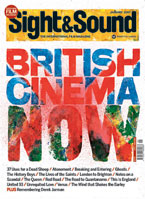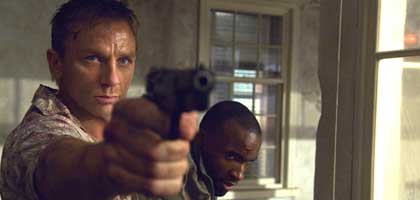Primary navigation

UK/USA/Czech Republic/Germany 2006

Reviewed by Roger Clarke
Our synopses give away the plot in full, including surprise twists.
Britain, the present. After earning his '00' status and licence to kill in an ugly rest-room assassination, James Bond is directed by MI6 to follow the activities of a villain named Le Chiffre in Madagascar, Miami and the Bahamas. Having been foiled in his attempt to make millions on the stock markets following a faux-terrorist attack on a prototype airliner in Miami, Le Chiffre is tracked to a casino in Montenegro, where Bond is instructed to take him out financially. During a game of poker, monitored by fellow British agent Vesper Lynd, CIA agent Felix Leiter and local M16 contact Mathis, Bond drinks a poisoned martini and is only saved by an advanced medical kit in his Aston Martin and the timely assistance of Lynd. Bond wins the game but his position has been compromised by Mathis, who turns out to be a double agent, and the kidnapping of Lynd, which results in a short car chase and Bond being tortured while tied naked to a chair.
Recovering near Lake Como and then Venice, Bond discovers that Lynd, with whom he has fallen in love, has been blackmailed to deliver the money he won in the poker game to Le Chiffre. A showdown takes place in a Venetian palazzo. Lynd drowns herself. The film closes with Bond tracking down über-villain Mr White, shooting him outside his lakeside villa.
The major Ian Fleming property never owned by Albert R. Broccoli, Casino Royale was always the one that got away. Someone working in US television snapped up the rights back in the 1950s and made a completely forgotten one-hour version starring Barry Nelson as Bond and Peter Lorre as the villain, Le Chiffre. It was remade by producer Charles K. Feldman in 1967 and turned into a sprawling, incoherent comedy featuring a multiplicity of Bond/007 characters, including one played by Peter Sellers. The latter's intense dislike for Orson Welles (playing Le Chiffre), which reached crisis point during the production, and his increasingly erratic onset behaviour remain the most memorable aspects of that production. But now the Broccoli family's production company, Eon, has finally got their paws on Casino Royale for Daniel Craig in his first role as 007, and, swatting aside a speculative offer by Quentin Tarantino to helm the film, rehired the man who directed Goldeneye (1995), Martin Campbell, to deliver something which can only be described as a franchise reboot.
Let's say straight off that Craig is very good indeed: everything about his performance shows cunning and grace. This is curious because he's made to do the kind of brutal things we associate with Jack Bauer in the US TV show 24, and he frequently looks more like a bouncer outside an Essex nightclub than a suave assassin of Her Majesty's employ. His slightly brutish Anglo-Saxon face is a strange and bony one, and, like the dinner jacket he's forced to wear, is bespoke when it comes to suggesting anxiety. This is a Bond that feeds on anxiety and is alive with inadequacies and flaws. He's a bundle of roped muscle and mental pain, not at all like his predecessor. Pierce Brosnan's swansong, Die Another Day (2002), was among the worst Bond films ever made, and, though that film made a lot of money at the box office, it's suddenly easy to see that Brosnan could never have continued in the role. The Broccolis carefully designed Goldeneye in part as a response to the Arnold Schwarzenegger-Jamie Lee Curtis film True Lies, which was seen at the time to have raised the action-thriller stakes. Casino Royale was always going to be their best riposte to The Bourne Identity. There is no Brosnan smarm in Craig's side-of-beef-swinging-in-an-abattoir James Blond. All the Celtic twinkle of all the Celtic Bonds has finally been erased from the fey and feckless end of the franchise.
The best set pieces all revolve around architecture, the most incredible romp being set on a building site in Madagascar, where Bond pursues a lead and leaps from steel girder to steel girder and from crane to crane. There is also a spectacular demolition of a Venetian palazzo, the very fabric of the building unable to sustain the pummelling it receives from Bond and the villains trying to kill him. With the film-makers resisting the temptation to compare the palazzo's collapse to that of a famous structure in New York, Bond's feverish fight to save the woman he loves (Eva Green) disappearing into the murky waters of the Grand Canal while trapped in an elevator cage is Bond's journey into the subconscious; and the heroine's chaotic and watery demise evokes both Leonardo DiCaprio's amniotic sinking into the Atlantic in Titanic and Olivia de Havilland's wide-eyed and raging Cornelia Hilyard in Walter Grauman's Lady in a Cage.
In perhaps a sly dig at poker-playing Matt Damon (in addition to The Bourne Identity, he also starred in Rounders, the film that started Hollywood's obsession with poker), there is an extended poker scene with a wealth of detail now only possible following the recent explosion of interest in the game, not least thanks to the many Hollywood actors involved in various Vegas escapades and Texas Hold'em websites. It is another sign of how incredibly aware the Bond producers are of shifting trends and interests. This is evident, too, in an unusually graphic torture scene, the lighting and photography of which are worthy of Jeong Jeong-hun. The urge to mess with the sleek look of the brand is evident throughout, from the often oxidised, sulphurous look of the colour grading to the treatment of the new Aston Martin (painted in the special film tie-in colour "Casino Ice") as little more than a glorified medical kit, to the killer line when Bond is asked by a bartender whether he wants his Martini shaken or stirred. "Do I look like I give a damn?" he snaps.
The casting of Paris-born Green also hints at a new direction; she brings a cool indolence to her role and is hardly a conventional Bond girl. Indeed, she's his boss when it comes to gambling with government money (ditto Judi Dench, returning as M, appalled to find he has broken into her apartment), and really not at all convinced he's up to the job. We learn that Bond prefers married women, and that he was, in some way not entirely specified, bereft and orphaned as a child. This is not a particularly nice or charming man (only Timothy Dalton has been less charming as Bond), especially when Craig's chromatic baby-blues betray a crystalline flash of incipient psychosis.
With one of the best opening animation sequences of recent years (up there with the work of Saul Bass, whose last credits were for the titles for Scorsese's Casino), after a gritty assassination in a public lavatory filmed in grainy black and white, the viewer is left in no doubt as to the nature of the film they are about to see: a reinvention with some slashed leather trails of a classic trim, a brutal Bond for a brutal age, with the chance and skill of the gambling table merging into a grim but compulsive volley at the vicissitudes of life.